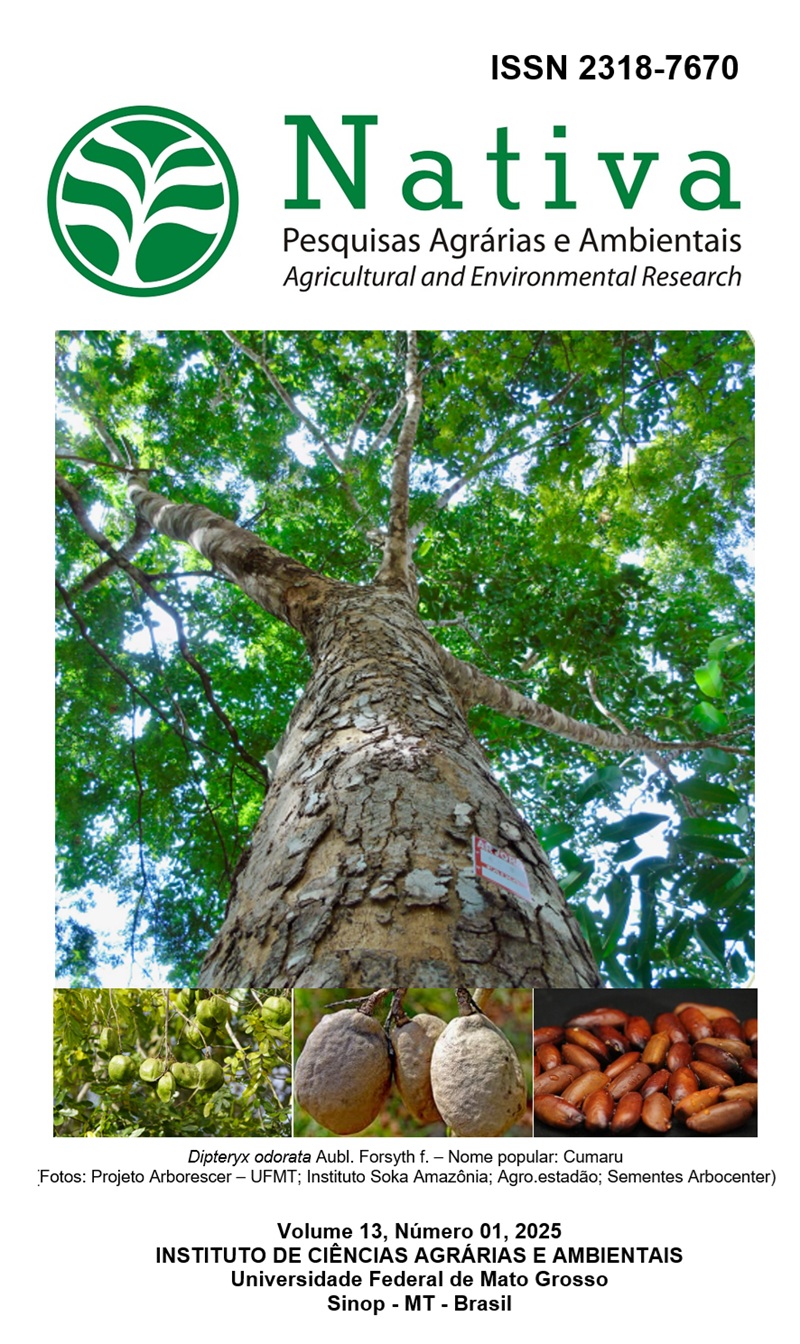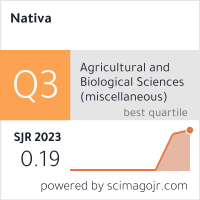STRATEGIES FOR CONTROL OF NITROGENATED COMPOUND CONCENTRATIONS IN THE Penaeus paulensis BFT CULTURE SYSTEM
DOI:
https://doi.org/10.31413/nat.v13i1.18187Palavras-chave:
Aquaculture, Shrimp Farming, Water Quality, Nitrification, NitriteResumo
The present study is of practical significance as it aimed to analyze the reduction of nitrite through two management strategies, potentially leading to a proposal for controlling this compound and improving water quality in the BFT system. The study focused on achieving an optimal organic carbon-to-alkalinity ratio and an optimal feed rate in the rearing of P. paulensis. Two experiments were conducted. While the study did not conclusively develop a tool for nitrite reduction by oxidizing nitrite bacteria, it did find that higher alkalinities promote the action of ammonia-oxidizing bacteria, creating a more conducive environment for biofloc development and improved water quality control. In a study aimed at determining the optimal feed rate, it was observed that higher feed reductions (30%) enhanced the activity of nitrite-oxidizing bacteria, thereby accelerating the nitrification process and potentially revolutionizing shrimp farming practices.
Keywords: aquaculture; shrimp farming; water quality; nitrification; nitrite.
Estratégias para controle das concentrações de compostos nitrogenados no cultivo de Penaeus paulensis em sistema de bioflocos
RESUMO: O presente estudo tem significativa relevância prática, pois teve como objetivo analisar a redução de nitrito por meio de duas estratégias de manejo, potencialmente levando à proposição de um método para o controle desse composto e melhoria da qualidade da água no sistema BFT. O estudo focou na obtenção de uma relação ideal entre carbono orgânico e alcalinidade, bem como em uma melhor taxa de alimentação no cultivo de P. paulensis. Dois experimentos foram conduzidos. Embora o estudo não tenha alcançado conclusivamente uma ferramenta para a redução de nitrito por bactérias oxidantes de nitrito, observou-se que maiores níveis de alcalinidade favorecem a ação de bactérias oxidantes de amônia, criando um ambiente mais propício para o desenvolvimento do biofloco e o controle da qualidade da água. No experimento que visava determinar a melhor taxa de alimentação, verificou-se que maiores reduções na alimentação (30%) potencializam a ação das bactérias oxidantes de nitrito, acelerando o processo de nitrificação e possivelmente revolucionando as práticas de cultivo de camarão.
Palavras-chave: aquicultura; carcicinicultura; qualidade de água; nitrificação; nitrito.
Referências
APHA_AMERCIAN PUBLIC HEATH ASSOCIATION. Standard Methods for the Examination of Water and Wastewater, 21ed. Washington, DC: American Public Health Association (APHA), 2005. 1100p.
AVNIMELECH, Y. Biofloc technology - A Pratical Guidebook. 3 ed. Baton Rouge, Louisiana, USA: World Aquaculture Society, 2014. 258p.
BALLESTER, E. L. C.; ABREU, P. C.; CAVALLI, R. O.; EMERENCIANO, M.; ABREU, L.; WASIELESKY, W. J. Effect of practical diets with different protein levels on the performance of Farfantepenaeus paulensis juveniles nursed in a zero exchange suspended microbial flocs intensive system. Aquaculture Nutrition, v. 16, p. 163-172, 2010. https://doi.org/10.1111/j.1365-2095.2009.00648.x
BENDSCHNEIDER, K.; ROBINSON, R. J. A new spectrophotometric method for the determination of nitrite in seawater. Journal of Marine Research, v. 11, p. 87-96, 1952.
BRANDÃO, H.; XAVIER, Í. V.; SANTANA, G. K. K.; SANTANA, H. J. K.; KRUMMENAUER, D.; WASIELESKY, W. Heterotrophic versus mixed BFT system: Impacts on water use, suspended solids production and growth performance of Litopenaeus vannamei. Aquacultural Engineering, v. 95, e102194, 2021. https://doi.org/10.1016/j.aquaeng.2021.102194
BRANDÃO, H.; REIS, W. G.; KRUMMENAUER, D.; WASIELESKY JR, W. Growth performance of Litopenaeus vannamei under biofloc system using denitrified seawater. Aquaculture International, v. 32, n. 3, p. 3129-3145, 2024. https://doi.org/10.1007/s10499-023-01315-0
CHEN, C.; WANG, F.; REN, Z.; WANG, X.; SHAN, H. Influencing factors on nitrite removal by bagasse bioflocs and the succession of attached microbial communities. Journal of Water Process Engineering, v. 59, 105057, 2024. https://doi.org/10.1016/j.jwpe.2024.105057.
CHEN, S.; LI, L.; DONG. X.; TIAN, X. Influence of carbon source supplementation on the development of autotrophic nitrification and microbial community composition in biofloc technology systems. Journal of Water Process Engineering, v. 71, e107215, 2025. https://doi.org/10.1016/j.jwpe.2025.107215
D'INCAO, F.; VALENTINI, H. E.; RODRIGUES, L. F. Avaliação da pesca de camarões nas regiões sudeste e sul do Brasil. Atlântica, v. 24, n. 2, P. 103-116, 2002.
EBELING, J. M.; TIMMONS, M. B.; BISOGNI, J. J. Engineering analysis of the stoichiometry of photoautotrophic, autotrophic, and heterotrophic control of ammonia-nitrogen in aquaculture production systems. Aquaculture, v. 257, p. 386-358, 2006. https://doi.org/10.1016/j.aquaculture.2006.03.019
FERREIRA, G. S.; SILVA, V. F.; MARTINS, M. A.; SILVA, A. C. C. P.; MACHADO, C.; SEIFFERT, W. Q.; VIEIRA, F. N. Strategies for ammonium and nitrite control in Litopenaeus vannamei nursery systems with bioflocs. Aquacultural Engineering, v. 88, e102040, 2020. https://doi.org/10.1016/j.aquaeng.2019.102040
FURTADO, P. S.; POERSCH, L. H.; WASIELESKY, W. J. The effect of different alkalinity levels on Litopenaeus vannamei reared with biofloc technology (BFT). Aquaculture International, v. 22, p. 1009-1023, 2014. https://doi.org/10.1007/s10499-014-9819-x
GAONA, C. A. P.; ALMEIDA, M. S.; VIAU, V.; POERSCH, L. H.; WASIELESKY, W. J. Effect of different total suspended solids levels on a Litopenaeus vannamei (Boone, 1931) BFT culture system during biofloc formation. Aquaculture Research, v. 48, n. 3, p. 1070-1079, 2015. https://doi.org/10.1111/are.12949
GROSS, A.; ABUTBUL, S.; ZILBERG, D. Acute and chronic effects of nitrite on white shrimp, Litopenaeus vannamei, cultured in low-salinity brackish water. Journal of the World Aquaculture Society, v. 35, n. 3, p. 315-321, 2004. https://doi.org/10.1111/j.1749-7345.2004.tb00095.x
HARGREAVES, J. A. Nitrogen biogeochemistry of aquaculture ponds. Aquaculture, v. 166, n. 3-4, p. 181-212, 1998. https://doi.org/10.1016/S0044-8486(98)00298-1
HENRIQUES, M. B.; ALVES, P. M. F.; BARRETO, O. J. S.; SOUZA, M. R. Growth of Litopenaeus schmitti(Burkenroad, 1936) and Farfantepenaeus paulensis(Pérez-farfante, 1967) shrimp reared in recirculation culture system. Brazilian Journal of Oceanography, v. 62, n. 4, p. 323-330, 2014. https://doi.org/10.1590/S1679-87592014078806204
IWAI, M. Pesca exploratória e estudo biológico sobre camarão na costa centro-sul do Brasil com o navio oceanográfico "Prof. W. Besnard" em 1969-1971. São Paulo: SUDELPA, Instituto Oceanográfico USP, 1973, 71p.
JORY, D. E.; CABRERA, T. R.; DUGGER, D. M.; FEGAN, D.; LEE, P. G.; LAWRENCE, A. L.; JACKSON, C. J.; MCINTOSH, R. P.; CASTAÑEDA, J. A global review of shrimp feed management: status and perspectives. The World Aquaculture Society, p. 104-152, 2001.
LARA, G.; POERSCH, L.H.; WASIELESKY, W. The quantity of artificial substrates influences the nitrogen cycle in the biofloc culture system of Litopenaeus vannamei. Aquacultural Engineering, v. 94, e102171, 2021. https://doi.org/10.1016/j.aquaeng.2021.102171
MACHADO, I. C.; MENDONÇA, J. T. Gestão pesqueira participativa do Complexo Estuarino-lagunar de Cananéia, Iguape e Ilha Comprida e Área Costeira Adjacente. In: PRATES, A. P.; BLANC, D. (Orgs). Áreas aquáticas protegidas como instrumento de gestão pesqueira. Brasília-DF: MMA/SBF, 2007. p. 79-98. (Série Áreas Protegidas do Brasil, 4)
MELO FILHO, M. E. S.; OWATARI, M. S.; MOURIÑO, J. L. P.; LAPA, K. R.; SOARES, H. M. Application of nitrification and denitrification processes in a direct water reuse system for pacific white shrimp farmed in biofloc system. Aquaculture Engineering, v. 88, e102043, 2020. https://doi.org/10.1016/j.aquaeng.2020.102043
OSTRENSKY, A.; WASIELESKY, W. JR. Acute toxicity of ammonia to various life stages of the São Paulo shrimp, Penaeu spaulensis Pérez-Farfante, 1967. Aquaculture, v. 132, n. 3-4, p. 339-347, 1995. https://doi.org/10.1016/0044-8486(94)00343-M.
PIMENTEL, O. A. L. F.; OLIVEIRA, V. Q. de; OLIVEIRA, C. R. do R.; SANTOS, E. P. dos; SEVERI, 2.; PASCO, J. M.; EMERENCIANO, M. G. C.;
GÁLVEZ, A. O.; BRITO, L. O. Nitrogenous compounds and alkalinity patterns in Penaeus vannamei nurseries and pre-grow-out with low salinity water and synbiotic system: a case study. Aquaculture International, v. 32, n. 2, p. 1703-1718, 2024. https://doi.org/10.1007/s10499-023-01237-x
PIMENTEL, O. A. L. F.; SCHWARZ, M. H.; VAN SENTEN, J.; WASIELESKY, W.; URICK, S.; CARVALHO, A.; MCALHANEY, E.; CLARINGTON, J.; KRUMMENAUER, D. The super-intensive culture of Penaeus vannamei in low salinity water: A comparative study among recirculating aquaculture system, biofloc, and synbiotic systems. Aquaculture, v. 596, e741774, 2025. 10.1016/j.aquaculture.2024.741774
RAMIRO, B. O.; WASIELESKY JR, W.; PIMENTEL, O. A. L. F.; SAN MARTIN, N. P.; BORGES, L. do V.; KRUMMENAUER, D. Different management strategies for artificial substrates on nitrification, microbial composition, and growth of Penaeus vannamei in a super-intensive biofloc system. Aquaculture, v. 596, e741853, 2025. 10.1016/j.aquaculture.2024.741853
ROBLES‐PORCHAS, G. R.; GOLLAS‐GALVÁN, T.; MARTÍNEZ‐PORCHAS, M.; MARTÍNEZ‐CORDOVA, L. R.; MIRANDA‐BAEZA, A.; VARGAS‐ALBORES, F. The nitrification process for nitrogen removal in biofloc system aquaculture. Reviews in Aquaculture, v. 12, n. 4, p. 2228-2249, 2020. https://doi.org/10.1111/raq.12431
SERRA, F. P.; GAONA, C. A. P.; FURTADO, P. S.; POERSCH, L. H.; WASIELESKY, W. J. Use of different carbon sources for the biofloc system adopted during the nursery and grow-out culture of Litopenaeus vannamei. Aquaculture International, v. 23, p. 1325-1339, 2015. https://doi.org/10.1007/s10499-015-9887-6
SEVERINO-RODRIGUES, E.; GUERRA, D. S.; GRAÇA-LOPES, R. Carcinofauna acompanhante da pesca dirigida ao camarãosete-barbas (Xiphopenaeuskroyeri) desembarcada na Praia do Perequê, Estado de São Paulo, Brasil. Boletim do Instituto de Pesca, v. 28, n. 1, p. 33-48, 2002.
UNESCO. Chemical Methods for Use in Marine Environmental Monitoring. Manual and Guides 12, Intergovernmental Oceanographic Commission, Paris, France, 1983. 53p.
VALENCIA-CASTAÑEDA, G.; FRÍAS-ESPERICUETA, M. G.; VANEGAS-PÉREZ, R. C.; PÉREZ-RAMÍREZ, J. A.; CHÁVEZ-SÁNCHEZ, M. C.; PÁEZ-OSUNA, F. Acute toxicity of ammonia, nitrite and nitrate to shrimp Litopenaeus vannamei postlarvae in low-salinity water. Bulletin of Environmental Contamination and Toxicology, v. 101, p. 229-234, 2018. https://doi.org/10.1007/s00128-018-2355-z
VINATEA, L.; GALVEZ, A. O.; BROWDY, C. L.; STOKES, A.; VENERO, J.; HAVEMAN, J.; LEWIS, B. L.; LAWSON, A.; SHULER, A.; LEFFLER, J. W. Photosynthesis, water respiration and growth performance of Litopenaeus vannamei in a super-intensive raceway culture with zero water exchange: interaction of water quality variables. Aquacultural Engineering, v. 42, p. 17-24, 2010. https://doi.org/10.1016/j.aquaeng.2009.09.001
WASIELESKY, W. J.; POERSCH, L. H.; MARTINS, T. G.; MIRANDA-FILHO, K. C. Chronic effects of nitrogenous compounds on survival and growth of juvenile pink shrimp. Brazilian Journal of Biology, v. 77, n. 3, p. 558-565, 2016. https://doi.org/10.1590/1519-6984.1841
XAVIER, M.; WASIELESKY JÚNIOR, W.; HOSTINS, B.; BEQUÉ, E.; KRUMMENAUER, D. The use of a flocculant additive and its effect on biofloc formation, nitrification, and zootechnical performance during the culture of Pacific white shrimp Penaeus vannamei (Boone, 1931) in a BFT system. Latin American Journal of Aquatic Research, v. 50, n. 2, p. 181-196, 2022. http://dx.doi.org/10.3856/vol50-issue2-fulltext-2777
XU, W.; ZHANG, D.; SU, H.; XU, Y.; HU, X.; WEN, G.; CAO, Y. Impact of biochar addition on biofloc nitrifying bacteria and inorganic nitrogen dynamics in an intensive aquaculture system of shrimp. Microorganisms, v. 12, n. 12, e2581, 2024. https://doi.org/10.3390/microorganisms12122581
ZAR, J. H. Biostatistical analysis. 5td ed. New Jersey: Prentice Hall, 2010. 944p.
Downloads
Publicado
Edição
Seção
Como Citar
Licença
Copyright (c) 2025 Nativa

Este trabalho está licenciado sob uma licença Creative Commons Attribution-NonCommercial 4.0 International License.
Direitos Autorais para artigos publicados nesta revista são do autor, com direitos de primeira publicação para a revista. Em virtude de a aparecerem nesta revista de acesso público, os artigos são de uso gratuito, com atribuições próprias, em aplicações educacionais e não-comerciais.
A artigos publicados nessa revista, podem ser reproduzidos parcialmente ou utilizados como referência por outros autores, desde que seja cita a fonte, ou seja, a Revista Nativa.
Copyright for articles published in this journal are the authors, with first publication rights granted to the journal. The journal shows open access, and articles are free to use, with proper attribution, in educational and non-commercial.
The articles published in this journal may be reproduced in part or used as a reference by other authors, provided that the source is quoted.






